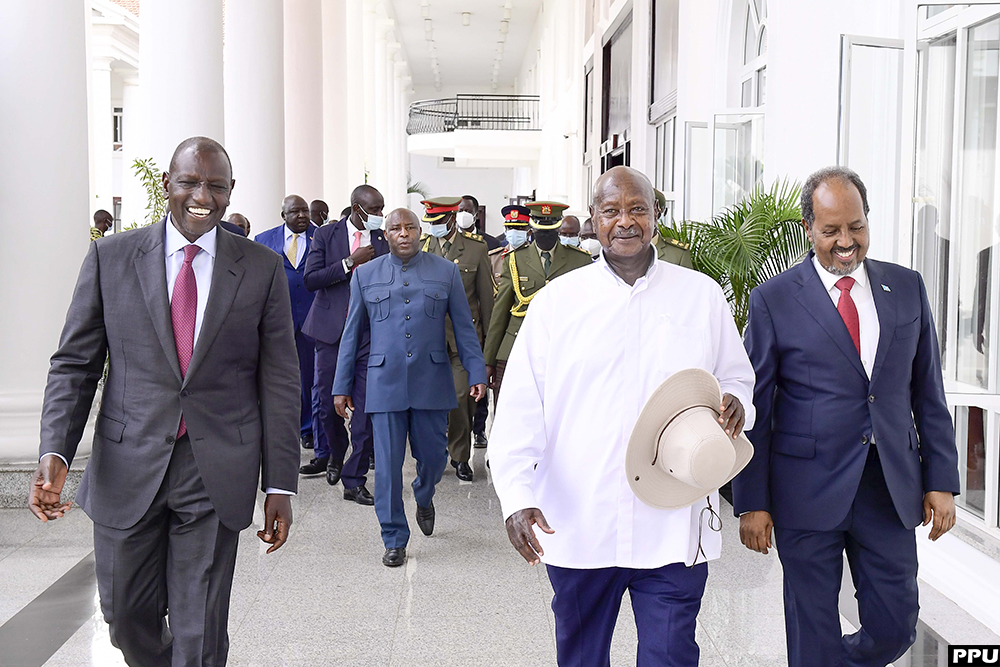
Why Ruto and Museveni seek a revised Atmis departure from Somalia
Concern among nations that supply troops has been raised by the impending withdrawal of additional African Union Transition Mission in Somalia (ATMis) and the force’s eventual mandate expiration at the end of this year. Presidents of Uganda and Kenya, Yoweri Museveni and William Ruto, have raised the alarm about the necessity of reviewing the pullout plan in order to prevent a security vacuum.
Following a meeting at State House in Nairobi on Thursday, the two leaders, whose nations provide troops to Atmis, expressed their concern about the threat of terrorism and insecurity “in our region and affirmed commitment to strengthen regional peace and security approaches and programs.”
4,000 Atmis troops are anticipated to leave Somalia by the end of June, in addition to the 5,000 who left the mission during phases one and two of the drawdown last year, according to the UN Security Council Road map. This has left openings for Al Shabaab elements to reclaim some lost territory.
President Ruto stated in the joint statement that “we expressed concern about the drawdown of Atmis in Somalia during my meeting with President Museveni and we urged that the timelines for the drawdown align with the security conditions on the ground in Somalia.”
Although this is a cautious stance, Somali civilian leaders who witness the brunt of Al Shabaab attacks on a regular basis and who urge a review of the drawdown plan in light of the security situation in attack-prone areas of the country, agree with this stance.
“We oppose anyone who suggests Atmis ought to depart from Somalia. Here, peace has been provided by our Atmis brothers. Shabaab will take over this site the day they depart, according to Haji Issa, the town of Ceeljaale’s chief of civil affairs in the Lower Shabelle district, southwest of Mogadishu.
Last month, Issa gave a speech at a gathering that included the women’s council, the town elders, and Col. Topher Magino, the commander of the Atmis area.
The Armed Conflict Location and Event Data (Acled) project, which this month recorded over 200 incidences of violent extremism with at least 539 fatalities reported between March 23 and April 19, states that central and southern Somalia continue to be security flashpoints.
The majority of casualties occurred in the Lower Shabelle region, when Al Shabaab boosted its attacks on security forces, accounting for 117 deaths, according to Acled. In addition, 114 people were reported dead in skirmishes between security forces and the terrorist group in the Mudug district.
The Galmudug and Hirshabelle regions, where Al Shabaab regrouped, reclaimed, and took control over large swathes of territory that Atmis forces had liberated, were also the sites of violent extremism and related deaths that security monitoring groups had reported earlier this month.
The ongoing withdrawal of AU force personnel, according to Federal Government of Somalia officials, has left a security vacuum. In September of last year, Hussein Sheikh Ali, Somalia’s national security adviser, wrote to the UN Security Council requesting a “technical pause” to postpone by 90 days the withdrawal of 3,000 troops who were scheduled to leave the mission at the end of that month.
He explained that this was due to the necessity of addressing major issues brought to light by the Joint Technical Assessment report of the previous drawdown, which outlined serious consequences for the security transition in Somalia should additional Atmis personnel depart the operation without sufficient replacement.
The Uganda Peoples Defence Forces (UPDF) spokesperson, Brig-Gen Felix Kulayigye, states that it is premature to remark on the stances adopted by the leaders of Kenya and Uganda. The Ugandan military joins the AU force with the largest contingent since 2007.
Ugandan officials said last month that their army will keep sending troops to Somalia when the current mandate expires on December 31, 2024. These troops will be part of the post-Atmis stabilization force, an AU-led mission with a primary goal of protecting civilians.
According to Ugandan commanders under Atmis, Somalia needs more time to build up a force capable of defending the large region. If the AU force withdraws, a security void may occur, providing Al Shabaab with an opportunity to seize power, much like the Taliban did in Afghanistan when US forces left in 2022.
The commander of the Uganda contingent, Brig-Gen Anthony Lukwago Mbuusi, made reference to open areas left behind when the peacekeepers withdrew during the two previous drawdowns in June and December 2023, giving Al Shabaab room to target people, during an interview with embedded journalists last month.
We will still have a force on the ground notwithstanding their orders to draw down. “Here, we are not going to establish an Afghanistan,” he declared.
“Whatever becomes of these places? Either the populace will join the militias or become open to attacks by Al Shabaab. It is evident that they are in a fix.
Ugandans will make up 1,000 of the 4,000 troops expected to leave at the end of June, increasing the stakes in protecting civilians under its operation area, which spans a vast area including over 240 kilometers of Somalia’s coastline, major highways, coastal towns, and nearby hinterland towns with numerous security flashpoints.
Just over 13,000 AU soldiers remain in Somalia, compared to 22,000 at the height of the deployment of all five participating nations. There will be just 9,000 military soldiers left in the mission following the drawdown in June.
The commander of Atmis, Souef Mohamed El-Amine, called the Somali National Amy a “young force” in an interview with VOA last year. He said that the force still requires a lot of help in training new recruits to increase its size and equip it with the skills necessary to take on the mission of defending people against the threat posed by Al Shabaab.
International partners have repeatedly cautioned that, despite drawdowns, the Somali government has not succeeded in generating enough force to replace the lost capability of Atmis numbers. The EU is one of Somalia’s most important partners in the reconstruction of the nation’s security sector.
The military might of Somalia is 15,000, with a reserve force of 2,000, trained primarily by Uganda, with additional training provided by international allies like Turkey and neighboring countries like Eritrea.
All Categories
Recent Posts
Tags
+13162306000
zoneyetu@yahoo.com



